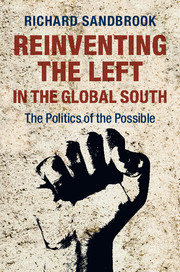During the past several years, I have spent a lot of time reflecting on the unpalatable dilemmas that confront the Left, both socialists and social democrats. What is the way out, for those concerned to build equal freedom and a more democratic society?
This is a theme I pursue at length in Reinventing the Left in the Global South.
A New Society Demands Transformed People
Socialists face a tough challenge. They intend to abolish capitalism’s inherent contradictions and attain their egalitarian goals by forging a new society. This society would be underpinned by such values and institutions as solidarity, equal freedom, participatory democracy and cooperative production. But such a society can work only if new men and women – those imbued with the requisite values and orientations – inhabit it. Yet most people in the existing capitalist society are immersed in the culture of possessive individualism and the competition of one against all, not to mention divisive ethnic or religious identities and authoritarian traditions. How do progressive movements reconcile this disparity between the requisites of the good society and the dispositions of real people – in the context of widespread disruption and conflict?
The Vanguardist Option
Two options present themselves. The first, a Leninist vanguard approach, was the chief answer to the dilemma in the 20th century. If people are not yet ready to assume self-determination in the new society, a vanguard comprising those with a more highly developed consciousness will play the leading role. Dedicated socialists will guide the people toward the correct mind-set and institutional arrangement (as well as crush external and domestic enemies).
This tutelary period will probably be authoritarian and certainly top-down, the better to forge socialist men and women and defeat enemies. When these goals are achieved, paternalism and authoritarianism are supposed to yield to expansive forms of democracy in the economic as well as political spheres. But this approach led to the Stalinist dead-end and ultimately the demise of state socialism in the Soviet Union, Eastern Europe and elsewhere. There were always reasons why the vanguard felt it could not give way to a genuine democracy. Why would the outcome be any different today? All political-economic systems tend toward oligarchy and inequality, unless checked from below.
The Democratic-Electoral Option
The alternative is to avoid the authoritarian tutelary phase by seeking peacefully and democratically to transform liberal-democratic capitalism from within. This approach requires winning the loyalty of a majority of the population in electoral campaigns and introducing programmes and campaigns that shift their values and behaviour in a cooperative, egalitarian and participatory direction. This end is to be achieved by constantly proclaiming the need for class conflict to overturn structures of inherited class/caste privilege – by redistributing property, especially land where vast inequalities obtain, expanding cooperative production and micro-enterprises, instituting participatory forums, especially at the local level, and building a universalistic welfare state.
But can the peaceful road to socialism succeed? The socialist party or coalition will need to build an electoral coalition that, in virtually all societies, will need to include a substantial portion of the amorphous middle class. Clearly, the organized working class today forms a smaller share of the labour force than in the 19th and 29th centuries, and is generally divided in its political loyalties. The socialist party may be able to appeal to the middle class, but usually only by moderating its platform. Furthermore, the rise of the transformational left will polarize society, with big business and its foreign allies responding in predictable ways: capital flight and capital strikes, constant denunciations in the mass media whose ownership is highly concentrated in private hands, and ultimately an economic and political crisis. Socialism in one country appears even less likely today than in the 1920s.
What is the Way Out of this Dilemma?
Gramsci’s ‘war of position’ is a possible answer in the longer term However, we find limited evidence that this strategy is succeeding – despite the discrediting of neoliberalism occasioned by the 2008 world economic crisis. These realities would seem to argue for the class-compromise approach associated with the social-democratic option, though this option too is subject to its own serious limitations, as a subsequent post will explore.
